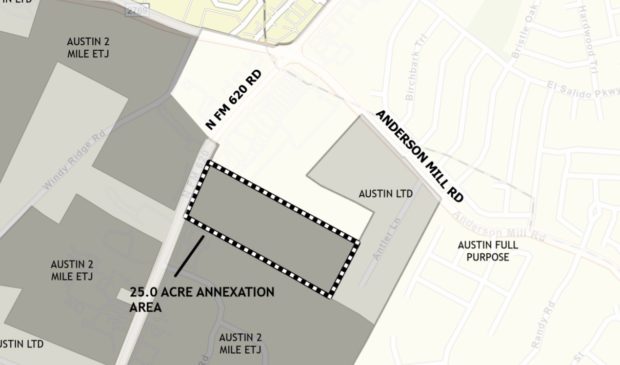Council OKs annexation for Bull Creek site
Monday, October 4, 2021 by
Jo Clifton With Council members Alison Alter and Kathie Tovo opposed, City Council on Thursday approved the annexation of a 25-acre site at 11213 FM 620 and ensured the administrative approval of redevelopment of a wastewater lift station close to the headwaters of Bull Creek. While environmentalists worry that allowing service could endanger the Jollyville Plateau salamander, which is on the U.S. Fish and Wildlife Service’s threatened species list, failure to provide the service would likely lead to an alternative form of wastewater disposal.
Austin Water was in favor of the annexation and subsequent provision of centralized wastewater service for a proposed multifamily development on the property, which is within the city’s Drinking Water Protection Zone. The Watershed Protection Department, on the other hand, was opposed to the annexation and provision of service. The city’s Environmental Commission recommended against the wastewater service, while the Water and Wastewater Commission voted in favor of it.
Jorge Morales, director of Watershed Protection, wrote a memo expressing his department’s concerns to the mayor and Council: “If annexation is approved, thus ensuring that the (service extension request) will subsequently be approved administratively, the development would require that an existing lift station be rebuilt, and a new second lift station also be constructed.”
He continued, “Buried pipes carrying large amounts of wastewater and lift stations have the potential to leak over time, which could potentially cause a large wastewater spill that would affect the creek in the future. The site plan under review … shows the location of the new proposed lift station to be located adjacent to a swale leading directly to a storm drain that outfalls into the creek. If that lift station were to fail, the wastewater would spill directly into the headwater creeks, which is known to support the threatened Jollyville salamander. Should annexation be approved, the Watershed Protection Department will work with Austin Water to identify strategies to mitigate the additional risks. Furthermore, we will continue to work to minimize the impacts as the infrastructure final design is completed.”
City Manager Spencer Cronk told Council that city employees have had a “complex and challenging discussion” amongst themselves about the best path forward for the property and the city. One important fact is that 25 percent of the property is already within city limits and has city water service, even though it lacks wastewater service. He assured Council that all of the city’s environmental regulations would apply to development of the site and noted that city staff would make sure that the new wastewater lines would not cross environmentally sensitive areas.
Austin Water Director Greg Meszaros told Council that the city has “the highest standards” for sanitary sewer overflows. When Council Member Ann Kitchen asked about recent news reports about long-buried leaking pipes, Meszaros pointed out that those were stormwater infrastructure, which do not fall under the authority of the water department. He insisted that the city’s wastewater infrastructure is inspected on a regular basis.
“This area is over the aquifer and we have a higher standard of inspections that we do over the aquifer, so we feel very confident about knowing the existing condition of the infrastructure and how we would maintain that going forward,” Meszaros told her. Sewer lines over the aquifer are inspected once every five years, and lift stations are under constant surveillance using an electronic network called SCADA, he explained.
Alter noted that the situation is complicated and that “reasonable people can disagree and choose to prioritize different things. For me, my biggest concern is potential pollution of the headwaters of Bull Creek, and so I’m going to vote against the annexation.”
Council Member Paige Ellis said she thought Council or a water committee should have further discussions about the interplay between annexation and service extension requests. “If it’s within the city limits already, it doesn’t come to Council. This has always been a tricky subject.” Noting that she would support the item, Ellis said she had “a lot of mixed emotions about it …. But I think it’s in the best interests of the city to be able to do this annexation today.”
The Austin Monitor’s work is made possible by donations from the community. Though our reporting covers donors from time to time, we are careful to keep business and editorial efforts separate while maintaining transparency. A complete list of donors is available here, and our code of ethics is explained here.
You're a community leader
And we’re honored you look to us for serious, in-depth news. You know a strong community needs local and dedicated watchdog reporting. We’re here for you and that won’t change. Now will you take the powerful next step and support our nonprofit news organization?








